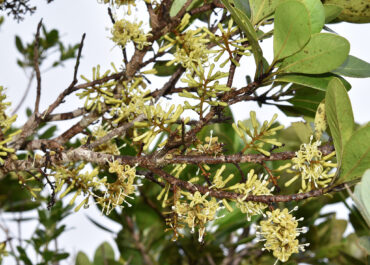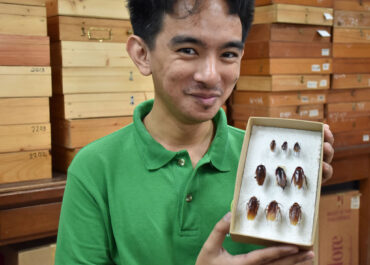
‘Tis that time of the year when hikers and nature-trippers flock to the mountains to “bathe in the forest” and meditate in observance of the Lenten Season. Many people especially those from the nearby urban areas climb Mount Makiling which is easily the most accessible natural forest park from Metro Manila.
While most people find the eco-tour of the mystical mountain which Los Baños locals hold dear as serene and peaceful, others can find luck in “discovering” a treasure which the deity Maria Makiling dutifully guards. Selfies and group pictures with this nature’s sensation have made rounds in social media and even recently featured on a regional TV news program.
The treasure being referred to is a rare beauty of a flower — the Rafflesia or commonly called malaboô — that hides itself for almost half of the year within the body of the Tetrastigma vine and then magically blooms from late February to June.
While most of the Rafflesias’ visitors go there for adventure and to commune with nature, scientists at the Museum of Natural History trek to the flower enclaves with other things in mind.
Drs. Ireneo L. Lit, Jr. and Aimee Lynn B. Dupo, curators of the museum’s entomological collection have made it a point to conduct their scientific “penitence” every Sunday this summer and visit the Rafflesia communities on Mt. Makiling. For them, any worthwhile observation can contribute to the conservation of these rare species of flora.
“We call it penitence because we feel that not enough research is being done to know the floral biology of Rafflesias, especially here in Mt. Makiling,” Dr. Lit explains.
For example, although it is known that Rafflesias are visited and/or pollinated by carrion flies, only one study on the floral biology of Makiling’s Rafflesia lagascae Blanco has been done, published in 2010.
“Scientists, and even hikers, have observed since the early 1990s that flies are present on the blooming malaboô,” Dr. Lit shares. According to Dr. Lit, the insects are probably attracted to the scent emitted by malaboô. “People say that the flowers emit a smell which resembles decaying meat, but I actually sensed ‘very close’ encounters, something like putrescent fish,” he adds. However, very few scientific records of visual observations on the insects that flourish on Rafflesias from the Philippines have been published.
That postulate has led Dr. Lit to observe the insects that visit the Rafflesia flowers every year for the past decade. “Insects are not only potential pollinators of the Rafflesia but may also have roles as consumers and decomposers,” he says.
By looking at the few collected vouchers of flies deposited at the entomological collection of the Museum of Natural History and photo vouchers provided by prominent Rafflesia specialists, Dr. Lit has compiled a species account of flies that visit Rafflesias.
The list included several blowfly species of the genus Bengalia, the Oriental Latrine Fly (Chrysomya megacephala), Green Bottle Fly (Lucilia fumicosta Malloch), Long-legged Flies (probably Condylostylus spp.), Vinegar Flies (Drosophila spp.),Common House Fly (Musca domestica L.), Humpbacked Fly (possibly Megaselia sp.), and the red-eyed Flesh Fly (Sarcophaga sp.).
The account has been published as a scientific article in the journal The Philippine Entomologist (click here to download a copy).
“We wanted to study the insects which make the parasitic flowers part of their lives,” Dr. Lit says.
Several studies on other Rafflesia species found in another country have shown that the flowers provide visual and olfactory cues important in attracting flies. Dr. Lit mentions that the anatomy of the Rafflesia makes it possible to ensure that flies capture pollen from the male individuals and transfer them to the females.
“We do really hope to learn more about the ecology of the malaboô, especially that they are so close to home, and of course, to our hearts,” he adds.
So, despite the restrictions on collecting insects associated with Rafflesias because of the possible damage to the flowers, Dr. Lit and his group are already content with the few but very significant opportunities they have had in closely studying the rare plant.
There might be no funding for this kind of research but Dr. Lit believes that just by hiking and enjoying a dose of health breaks, fellow scientists can produce more scientific knowledge on the Rafflesia.
“It is a sacrifice for us curators of the Museum, and also of course for our peers in the field, but all we need is dedication and commitment,” Lit says.
Thus Dr. Lit encourages people to show appreciation of their close encounters with Makiling’s rare gems and express the need for conserving the Rafflesia in their own small way. He however reminds everyone to make sure that no harm befalls on the Rafflesias during one’s heat of excitement of seeing them.e your Makiling climb worthwhile, be one with and speak for Nature. Spread the word that not all things with flies are rotten,” he advises.
“The Rafflesia is something to behold and its relationship with insects is a wonderful example of the great mysteries of Life which science may be able to tell,” Dr. Lit ends.
Search
Archives
Categories
- Announcement (21)
- Feature (21)
- News (141)
- Press Release (55)
- Research (4)
- Services (3)



